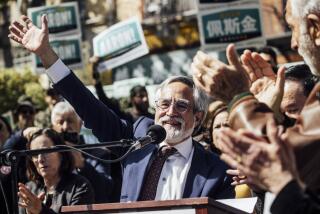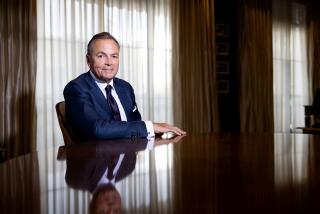Rick J. Caruso: A work in progress
Los Angeles is full of a lot of private moguls and a lot fewer public moguls, and Rick J. Caruso is one of the latter -- an immaculate, slightly Italianate master of his universe, with a bit of a retro vibe. The retail superstar conceived and built the Grove, the Americana at Brand and the Commons at Calabasas and is laboring on projects in Montecito and near the Santa Anita racetrack. But he has also thrown himself into civic life, as head of two of the city’s most powerful boards, the DWP and the Police Commission, as a charitable force and as a man in the political mix as a possible candidate for mayor. The Grove and its ilk may not be your cup of tea. Caruso has been slammed for creating a cleaned-up alternative retail reality, but millions disagree with you. In 2006, according to Los Angeles magazine, more people hit the Grove than went to Disneyland.
You were a little kid who wanted to be a developer when you grew up. What put that idea in your head?
The only thing I can say is, I love buildings, I love architecture, I wanted to be successful from a very early age, and I knew I had to make money to get what I wanted. I could walk Madison Avenue all day long. I love the streets of Boston. I like being around things that have energy and life.
Can a development really create that energy?
I think we did in Glendale. I think we did at the Grove. The thing I’m most proud of about our properties is that they get really woven into the fabric of the community. People go jogging through, walking their dogs or their kids, meeting friends. People never buy a thing; that’s fine. It’s their little downtown.
What about the more colorful elements of urban life? Street characters and the like? For example, were there Salvation Army bell ringers at the Grove?
No. They were on the Farmers Market side, but not the Grove side. We are very charitable, [but] the one year we had [bell ringers], people complained a lot -- a little bit too aggressive.
The Salvation Army?
Some of the people can be. It’s not the old Salvation Army you and I remember, nicely dressed, courteous.
Speaking of charity, Eli Broad is the go-to philanthropist of his generation in L.A. What’s your philosophy for your generation’s philanthropy?
Your business life, your philanthropy and your civic life should all go together. Tina [his wife] and I choose to give quietly, and our focus is on children’s needs: healthcare, schools, churches, synagogues, Childrens Hospital, Para los Niños. Younger people have to give back. There’s a very small handful who are really active, to be honest.
How do you get ordinary Angelenos more civically engaged?
I don’t know the right answer. A big part is who the elected officials are. Maybe they aren’t very interesting or engaging.
And yet Arnold Schwarzenegger is undeniably a big personality, and even he couldn’t make it happen.
God bless Arnold. He’s got this incredible optimistic gene. I think this state’s unmanageable. The system is just screwed up. You’ve got to break it apart and start all over again. It can’t keep going on the way it is.
You considered running for mayor last year. Is that still a possibility?
Absolutely it is. I would want to be mayor more than governor because I think you can have more impact on people’s daily lives. And I want to come home at night, be with my wife and kids. If there was somebody out there I thought was really good, I would gladly step aside. But I do like the idea and the challenge of doing it. Time will tell.
The city, like the state, has a huge budget problem. Just about every department’s taking a big hit.
LAPD shouldn’t take a hit. Paramedics and fire don’t take a hit. You pay your taxes, you expect good basic services. Cut noncore services. A couple of months ago, our street [was] being paved. Our street in Brentwood doesn’t need to be repaved.
Send them to my neighborhood!
Maybe your neighborhood does, but we’re going to survive in Brentwood without [it]. Be a leader. Make tough choices. Reallocate the budget. No different than you would do in a business.
You cast yourself as socially moderate, fiscally conservative, in the Schwarzenegger mold.
I call myself a pragmatist. I think the parties are a bunch of hullabaloo. I don’t really stick with party lines. I don’t think life comes in a box, so don’t put every issue in a box.
And you’re supporting Democrat Jerry Brown for governor -- a former governor, attorney general and Oakland mayor.
That’s what really got me focusing on the importance a mayor can make in a city. I think Jerry did a great job in Oakland. Great job. And that’s why I’m going to support him as governor. And I’m going to probably piss off a lot of my Republican friends, which is fine. But Jerry -- I’m eager to see him have a chance. He’s a great guy. He’s a fun guy. Very smart.
Critics of the Grove and the Americana say they turn their backs on the real city street.
I don’t think I turn my back on the streets. We’ve created a street within the city. We don’t have some rule that we turn our back on the street, but we do want to create energy in a confined space. There’s areas I would love to redo. On the way home, I drove through Westwood -- dead. It just broke my heart. What a waste. Westwood should be a great thriving district, but now you’ve got a bunch of junk, just junk.
Would you ever build something like the Grove in South L.A.?
I would love to. I would love to build something in East L.A. You’ve got to build something successful or you’re not doing a favor to that community. We’ve looked; we haven’t found the right opportunity, but I would love to do it, absolutely.
What’s necessary to make that a success?
You’ve got to buy the land at the right price. You’ve got to get the right entitlements. The right retailers to serve that community. You’ve got to get enough customers to use it, spend money, support the rents. A lot of very low to moderate income areas really thrive. I think if conceived right it can be done. East L.A., Boyle Heights, I just haven’t found the right areas.
Your critics also say your developments are cookie-cutter. Do you want every part of town to look like Rick Caruso did it?
Oh God, no. That would get stale and boring. You’ve got to have it mixed up a little bit.
The writer Pete Hamill went on and on to me about how great it is to just walk downstairs to get coffee and a newspaper in New York City. I told him that in L.A., when you live close enough to walk to the store, it’s time to move.
That’s what we have to get away from. At the Americana, the whole idea [is] people can walk downstairs, grab a paper, go to the movies, go to dinner, shop. You shouldn’t have to get in your car. I don’t think it’s for everybody, but a big group of people want to live in that environment.
The recession’s making a dent in recreational shopping. Will people retreat from these spaces?
I think people are going to be careful with their money for a long time, which they should be, but people are thirsting for a sense of community and an environment that somehow enriches them. Give that to them and they’ll respond mightily, because it’s pretty, it’s clean, it’s fun, it’s alive. A mall becomes much more destination shopping. You’re not hanging around four or five hours like you would at the Grove.
They’re technically private property. Has the line between public and private been blurred?
If we do our job right, it’s blurred. It should be mostly seamless.
You love mid-century style, and you make sure Frank Sinatra and singers like him are playing throughout the Grove. Does anyone ever tell you to put on something more modern?
They do, but it ain’t going to happen -- not on my watch. They try to convince me to put in AstroTurf. No way. Real grass. Real Sinatra. Real Tony Bennett.
Your kids are the models for the statues at your projects. Are they embarrassed?
They’re always embarrassed -- “Dad, please don’t do it.” But I can see the grins on their faces. I hope to God they’ll one day walk their kids through these properties and say, “Your grandpa built this, and that’s how old I was.” It’s a little piece of our family history, and that’s why they’re there. That’s my gift.
That’s a sentimental thought.
I’m very sentimental. So I cry when we unveil the statues. I cry at everything. I’m a crier.
When people compare your projects to Walt Disney’s work, is that a compliment?
Yes, yes! He was a great designer, a great visionary. He knew how to please his customers. He built something that has lasted. People still flock to it; it’s clean, it’s safe, it’s interesting. So yes, I take it as a compliment. I’m sure people criticized when the Colosseum was built, when the Vatican was built. And now they’re drooling. What I do is not by any means the Vatican or the Colosseum, but there’s always critics. I listen to them; I learn from them.
Imagine that in 80 years, someone wants to tear down the Grove. Will the Los Angeles Conservancy be picketing to save it?
Absolutely they will, because it’s part of the fabric of the community.
You don’t use the word “mall,” and “project” doesn’t sum it up. What word describes what you build?
I don’t know [he laughs]. The coined word is “lifestyle center” but I don’t actually like that.
It sounds like a gym.
Exactly. If you come up with a better word, let me know. Be happy to pay a royalty!
This interview was edited and excerpted from a taped transcript.
More to Read
Inside the business of entertainment
The Wide Shot brings you news, analysis and insights on everything from streaming wars to production — and what it all means for the future.
You may occasionally receive promotional content from the Los Angeles Times.











